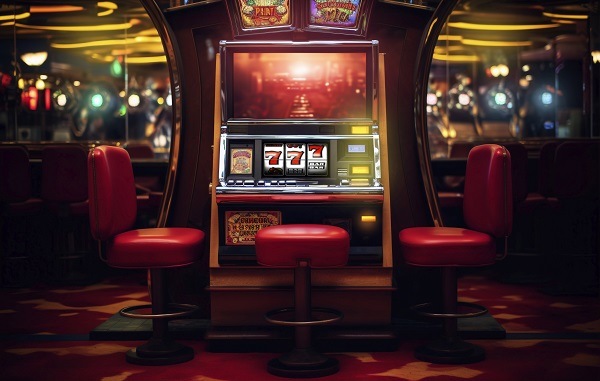When you take a seat at a slot machine, it’s worth noting the meticulous design elements that contribute to its overall appeal. The colors, button placement, and audio-visual effects are all carefully planned to engage players.When you take a seat at a slot machine, it’s worth noting the meticulous design elements that contribute to its overall appeal. The colors, button placement, and Magnum888 audio-visual effects are all carefully planned to engage players.
The psychology of slot machine design delves into more than just chance; it considers how human behavior and technology intersect in this gaming environment.
Exploring the world of slot machines unveils a realm where design elements are strategically employed to capture attention and enhance the overall gaming experience.
The Psychology of Slot Machine Design
Understanding the psychological principles behind slot machine design is crucial for understanding the influence these machines have on player behavior.
Player behavior is closely tied to cognitive psychology, which examines how individuals process information, make decisions, and interact with their environment.
In the realm of slot machines, cognitive psychology investigates how players perceive patterns, predict outcomes, and respond to wins or losses.
Design components of slot machines, including visual stimuli, color schemes, and symbols, are intentionally crafted to impact players’ cognitive processes and emotional responses.
By leveraging cognitive psychology, developers can create engaging experiences that keep players interested and coming back for more.
This convergence of player behavior and cognitive psychology is fundamental to effective slot machine design.
Impact of Sound Effects on Players
The incorporation of sound effects in slot machine design has a significant impact on players’ emotional responses and engagement levels. Research indicates that players’ behaviors are influenced by the sounds they hear during gameplay, as specific auditory cues can trigger distinct reactions.
Sound psychology is a key component in creating an immersive gaming environment that captivates players. Studies have demonstrated that the use of celebratory sounds following a win can improve players’ mood and reinforce positive gaming habits, potentially motivating them to continue playing.
Conversely, the inclusion of suspenseful sound effects during near-misses can increase tension and drive players to pursue the desired win. By recognizing the nuanced connection between sound effects and player behavior, designers can effectively shape the overall gaming experience and enhance player engagement.
Role of Colors in Slot Machines
Colors play a significant role in slot machines by influencing players’ cognitive processes and emotional responses during gameplay. Color psychology suggests that different colors can elicit specific reactions in individuals.
Bright and vibrant colors are commonly utilized to attract players and create a visually appealing environment. For example, red is often linked to excitement and energy, which may motivate players to continue gambling. Conversely, blue and green hues are employed to instill a sense of calm and relaxation in players.
The color scheme of a slot machine can notably impact player attraction and consequently influence their gambling behavior. Understanding the role of colors in slot machines is crucial for developing games that effectively engage and retain players.
Influence of Button Placement
The strategic placement of buttons on a slot machine interface significantly affects player engagement and interaction patterns. Research suggests that the positioning of frequently used buttons like ‘Spin’ or ‘Bet’ can have a substantial impact on user experience. Placing these buttons within easy reach enhances user engagement by enabling quick access to essential functions.
Conversely, poorly placed buttons can lead to user frustration and disengagement, negatively affecting the overall player experience. Studies have demonstrated that button placement influences the speed and frequency of player interactions, thereby affecting immersion levels and enjoyment.
Understanding the correlation between button placement, user experience, and player behavior is crucial in designing slot machines that effectively optimize player engagement.
Technology Behind Random Number Generators
Random number generators (RNGs) serve as a critical component in ensuring the fairness and unpredictability of slot machine outcomes. These RNGs operate by utilizing complex algorithms to produce a wide range of numbers with specific mathematical probabilities.
Through the implementation of advanced algorithms, RNGs are designed to prevent patterns or predictability in the sequence of numbers generated, thereby guaranteeing that each spin is entirely independent from the previous one. This technology plays a crucial role in maintaining the randomness of outcomes in slot machines, adhering to stringent regulations to uphold fairness in gaming practices.
Players can rely on the assurance that their winning odds remain unaffected by external influences, thereby fostering transparency and impartiality in the gaming environment.
Player Engagement Through Bonus Features
Bonus features in slot machines are strategically designed to enhance player engagement by providing additional excitement and rewards during gameplay. These features often include interactive elements like mini-games or pick-and-win scenarios, which allow players to feel more engaged and in control of their gaming experience.
The use of visual stimuli, such as vibrant graphics and animations, further contributes to the immersive gameplay and increases player enjoyment. These bonus features not only offer the potential for increased winnings but also serve to break the monotony of spinning reels, creating a dynamic and stimulating environment that encourages continued play.
Evolution of Slot Machine Graphics
The evolution of slot machine graphics has been heavily influenced by technological advancements, leading to improvements in visual appeal and player engagement. Graphic innovations have played a pivotal role in enhancing the overall gaming experience for players.
Over time, slot machine graphics have transitioned from simplistic pixelated designs to intricate 3D animations, aiming to captivate players and create a more immersive environment. The modern slot machines are strategically designed to attract and retain players through vibrant colors and dynamic visuals.
These advancements in graphics not only enhance the visual aesthetics of the games but also contribute to a more interactive and enjoyable player experience, fostering a more immersive and engaging gaming atmosphere.
Importance of Payout Percentages
Payout percentages in slot machines play a critical role in determining player returns and overall gaming experiences. Understanding the concept of game volatility and return to player percentages is essential for managing player expectations effectively.
Games with higher volatility typically offer larger payouts but less frequently, resulting in a more unpredictable gaming session. Conversely, low volatility games provide more frequent wins, albeit with smaller payout amounts.
Return to player percentages signify the average sum that players can anticipate receiving back over a period of time. It’s crucial to take these factors into account when selecting a slot machine to play, as they significantly impact the potential risks and rewards involved.
Conclusion
In conclusion, the science behind slot machine design is a complex and strategic process that leverages cognitive psychology, sound psychology, color theory, button placement, and RNG technology to create engaging and immersive gaming experiences.
By understanding and implementing these elements effectively, designers can influence players’ perceptions, emotions, and behaviors, ultimately shaping their overall gaming experience.
The intricate blend of these components showcases the meticulous attention to detail and research-driven approach in the development of slot machines.



